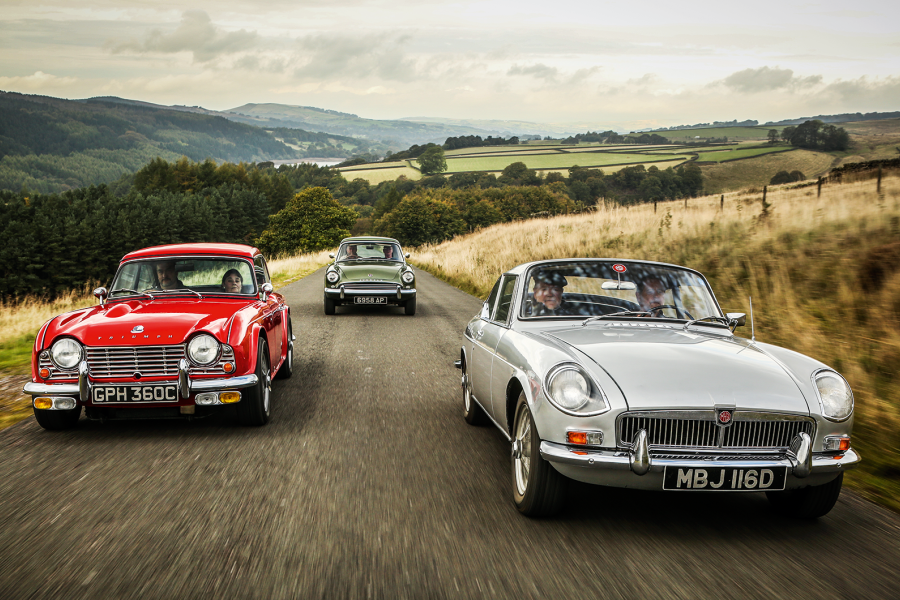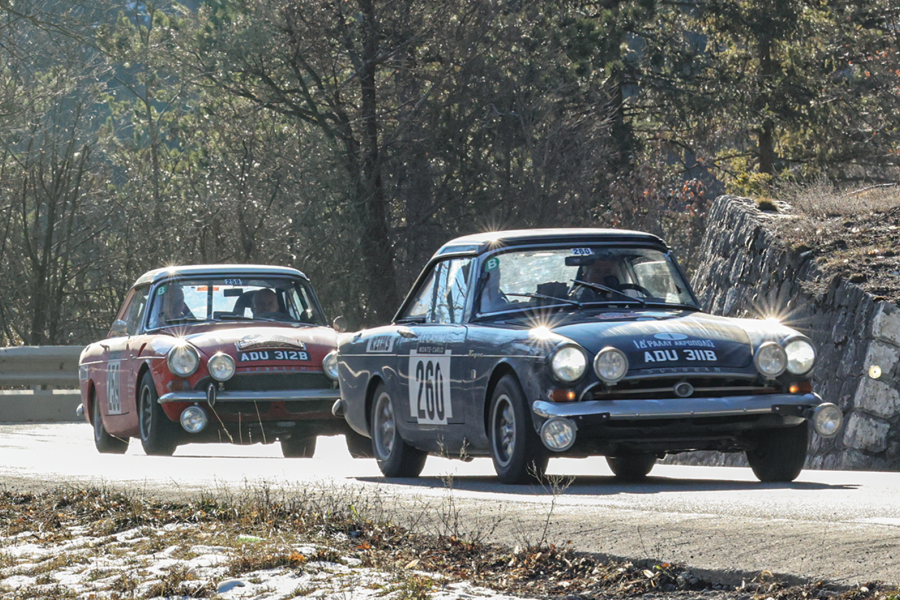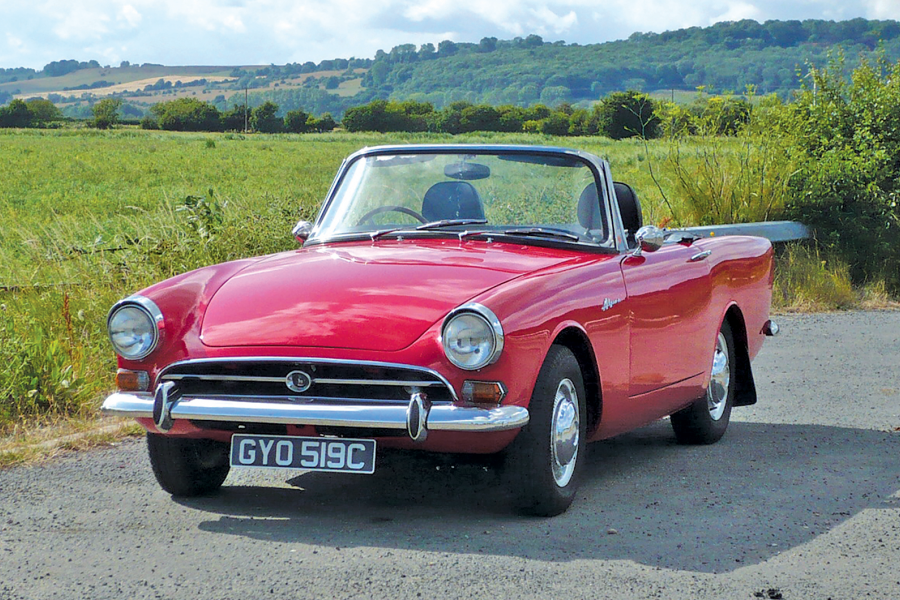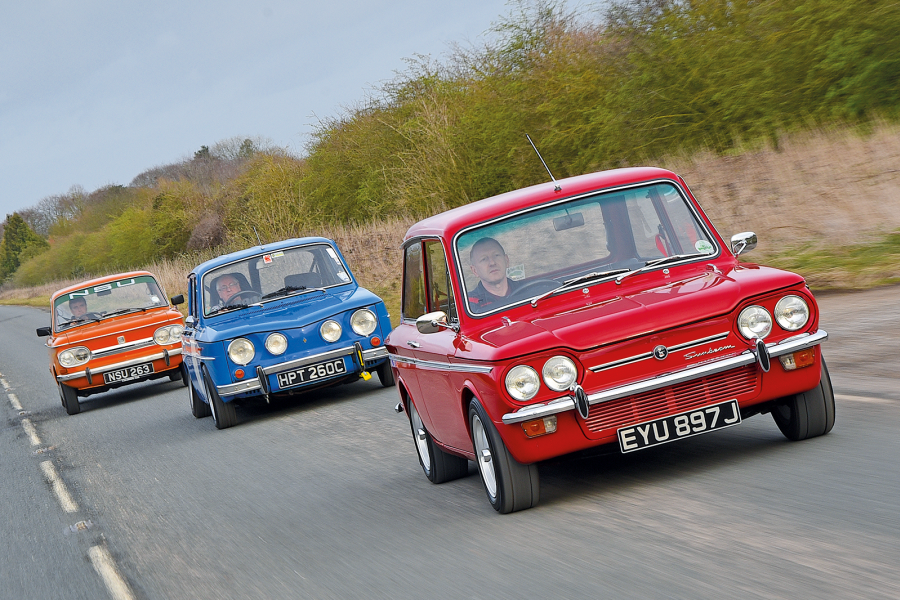She might not appreciate the poor lock while manoeuvring it out of the WI car park, but your grandmother could easily drive this magnificent machine.
The Tiger is happy to potter, too. If you’re not in a rush it will happily amble along, the seamless band of torque carrying it along effortlessly.
It’s so flexible, in fact, that in 1965, Country Life was moved to say that it ‘could be driven in town in the manner of a ceremonial limousine’.
An automatic ’box was considered as an option, but it would surely be superfluous: the mechanical unit is to all intents and purposes a semi-auto with the effortless torque.
Graham Vickery bought HRS 121E in the 1990s
There’s a limo-like quality to the fixtures and fittings as well.
The lovely timber dashboard and elegant wood-rim wheel have a genteel sense of occasion similar to that of a large Humber – all very civilised and dignified.
But don’t be misled into thinking that this car is a softly-softly boulevardier.
Slip on a pair of lead-soled loafers and that lazy V8 wakes up, punching you forward with iron-fisted vigour.
“In 2004, a group of us took our cars to the Le Mans Classic,” remembers Vickery.
“I was with Jimmy Blumer, who had raced a works Tiger there in 1964, and he floored the throttle as we rounded Tertre Rouge onto the Mulsanne Straight.
“We were soon pulling 5000rpm in top, which gave us an indicated 125mph.
“He was in his late 70s at the time, and often reminisced to us about it afterwards – it was certainly a rejuvenating experience for him!”
The neat, well-designed hood folds out of sight behind the seats
The short wheelbase and heavy lump of metal under the bonnet mean that if you really press on you could find yourself dealing with either understeer or oversteer, but at less than ludicrous velocity it feels wonderfully benign and utterly beguiling.
It is with a real tinge of sadness that I return the keys to Vickery at the end of our photoshoot, and I’m not alone in having been seduced by the Sunbeam.
C&SC’s Mick Walsh and Julian Balme both have a soft spot for the Tiger’s mesmerising character (see below).
“With the benefit of hindsight, the end of the Tiger production run was perhaps timely,” reflects Vickery.
“It was a car of its era, and had done its job.”
He has a valid point: there would be no ignominious power-sapping smog controls or ugly impact-absorbing bumpers for the Coventry roadster, no embarrassingly antiquated road manners alongside more modern rivals.
The Sunbeam bowed out as an unsullied design with its head held high, an unqualified success of which its maker could be justifiably proud.
But having experienced what a delight this lovely little V8 can be, it’s hard not to lament its short life and relatively low production numbers.
Long live the Tiger!
Images: Tony Baker
Thanks to: Graham Vickery and the Sunbeam Tiger Owners’ Club
This was originally in our April 2017 magazine; all information was correct at the date of first publication
Sunbeam Tiger memories
All hands on deck to swap the Sunbeam’s throttle cable © Pauline Gullick Photo
Rosemary Smith
“I first drove a Tiger on the Geneva Rally in 1964,” says former works driver Rosemary Smith.
“Before that, I’d been competing in an Imp, which was so slow.
“In comparison, the Tiger was a wonderful thing – I loved it! It was heavy to drive, a real challenge, but when you put your foot down that grunty V8 was better than anything and sounded great.
“The back end used to break away merrily, though, and with manual steering it wasn’t easy to catch.
“Today, a lot of people fit power steering, which makes life a lot easier.
“Although I only completed one rally for Rootes in the Tiger, I did a lot of publicity work promoting it in the ’60s and in recent years have been on a lot of historic rallies in places such as America, New Zealand and even Marrakesh.
“I’m also very involved with the club, having been made honorary president.
“I took part in the run to Monte a few years ago in Graham’s left-hand-drive car (AF6).
“The throttle cable snapped in the middle of France, but by a stroke of luck the only other left-hooker on the run – which had come over from America – was right behind and carrying a spare.
“The Tiger was such a fantastic car, I’d love to own one myself.”
Track action in a Sunbeam Tiger confirmed Mick Walsh’s love for the British sports car
Mick Walsh
The frustrations with racing my Alfa Duetto in the C&SC Novice series in the late ’80s, plus the indoctrination of pal Julian Balme, led me to the Tiger.
The Rootes rocket ticked so many boxes, not to mention its association with hero Ken Miles, who did the development work on the hot-rod Alpine.
From the tyre-smoking demonstration outside Haymarket’s offices, HAH 272D delivered more laughs per mile than any car I’ve owned.
Be it languidly touring across the Yorkshire Dales, or blasting around Silverstone’s old Woodcote corner during my first VSCC Pomeroy Trophy, this tough classic had an addictive split personality.
Second only to Balme’s Carrera-homage Lincoln ‘Wooly Bully’, my first Tiger brought my top motoring experiences.
From the dawn convoy with Balme’s ’64 Galaxie across London and up the A1 to England’s mini Nürburgring, my first race at Cadwell was a hoot.
Over-enthusiasm with the power on hard rubber had me spinning three times, but I’ve never laughed so much inside a lid.
The undoubted highlight was the 1990 Pirelli Classic Marathon.
Over the 3000-mile trans-Europe adventure to Cortina and back, the Tiger reaffirmed its appeal as the perfect endurance rally car.
Gunning the bumperless HAH up the Stelvio at dawn to avoid the coaches – and chasing home in convoy with two works Tiger rally cars via the Schlumpf collection – will never be forgotten.
I’d love another, but I feel that I am lucky to have enjoyed a Tiger during a special era of the classic hobby.
A lightbulb moment in a Sunbeam Alpine V led Julian Balme to his first Tiger
Julian Balme
I have to say that it was my late wife Karen’s fault.
She passed her test before me and – without my assistance – went out and bought a Series V Alpine.
The car was only an advisory away from being scrapped, but we both loved driving it.
One day we pulled up at a set of lights next to a Mustang, whereupon there was one of those lightbulb moments – this cute car with that noisy V8 engine.
I ended up with three Tigers at one point, but now have only HYC 792D – the car that I raced for three seasons with the HSCC.
I’ve always thought that Tigers were underrated.
Sure they’re heavy and over-built and have silly little wheels and inadequate brakes, but they are much less obvious than a Cobra and more comfortable than a Healey.
Sadly, most of them fell into the hands of amateur hot-rodders in the early ’70s – one of mine was painted metal-flake orange, while another had numerous glassfibre air dams stuck on it – so finding a nice original example is quite a challenge.
Rootes didn’t have the best range of colours so, again, too many have been painted red and now sport 14 or 15in wheels with rubber-band tyres.
I’d have a second roadgoing Tiger in a heartbeat if I could find the right car.
Sunbeam Tigers on tour
Sunbeam Tigers are great for road trip adventures
In 2014, to celebrate the 50th anniversary of the model’s launch, the Sunbeam Tiger Owners’ Club organised a number of European events, the highlight of which was the TIGER50 Monte Tour.
The 10-day tulip rally drew 40 cars from seven countries, including the US pairing of Bill Rogers and Peter Valentine who shipped their car from California, as well as Ross and Jan Baillie and Charles Seaburg, who brought their cars from Australia.
Other festivities to celebrate the half-century included a trip to the Le Mans Classic as well as the Normandy beaches and a Loire Valley wine tour.
The club rounded off that year’s activities with a superb display of cars at the Lancaster Insurance Classic Motor Show at the NEC.
In 2017, to mark 50 years since the end of Tiger production, a group of British cars travelled to America to join a California tour.
Graham Vickery took part in such an event for the 30th anniversary in ’97 driving HRS, but shipped AF6 to the States for the 2017 celebration.
Enjoy more of the world’s best classic car content every month when you subscribe to C&SC – get our latest deals here
READ MORE
Sunbeam Tiger vs Lotus Elan: brains or brawn?
Sunbeam Alpine: driving the original James Bond car
Celebrating the cars and more of Thomas Harrington & Sons
Malcolm Thorne
Malcolm Thorne is a contributor to – and former Deputy Editor of – Classic & Sports Car




















